When cooling can’t compromise hygiene – Maitokolmio chose the Rex Nordic HP-60
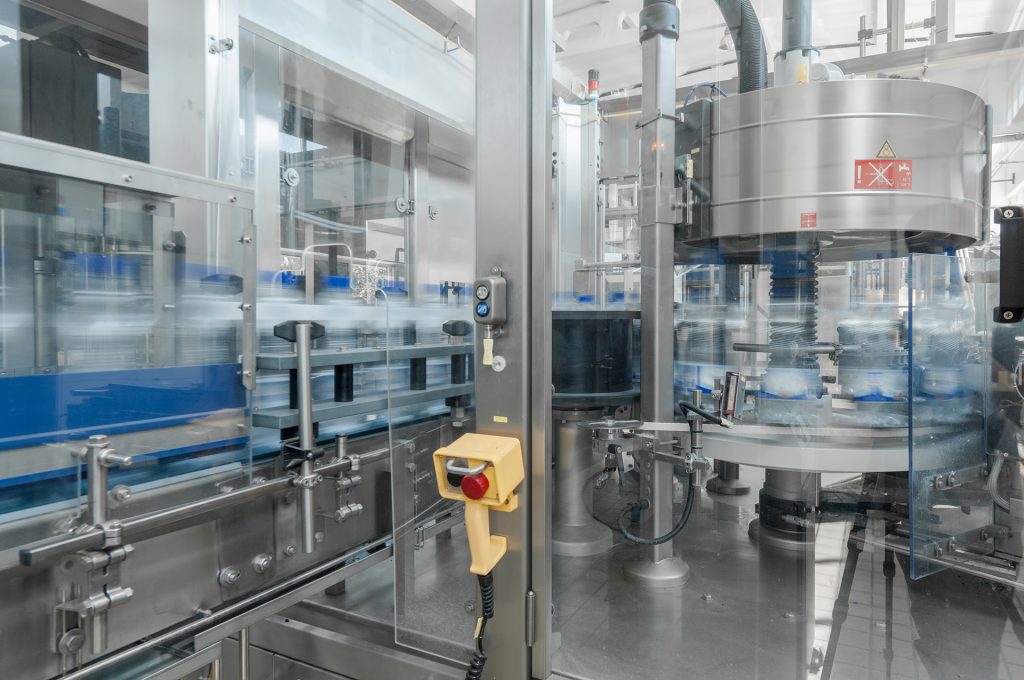
Temperature control is a critical part of food production — not only for product safety, but also for employee working conditions. Maitokolmio, one of Finland’s most well-known dairy producers, faced a challenge in its large-scale production facilities: rising indoor temperatures were affecting both process efficiency and staff wellbeing. A trusted Finnish food industry company Maitokolmio is a 115-year-old Finnish dairy company that produces and processes milk, quark, cream, and other dairy products. The company operates two production plants in the Ostrobothnia region — one in Toholampi and another in Sievi — and is owned by local milk producers. Maitokolmio employs around 100 people. High temperatures affect productivity and product quality A lot of heat is generated in Maitokolmio’s production areas — both by the processes and the people working there. Tasks such as pasteurization and packaging significantly raise the ambient temperature. Dozens of employees work in these spaces daily, and excessive heat can impact both ergonomic conditions and the precision required in dairy processing. In food production, air conditioning systems must do more than just cool the space — they must be hygienic, reliable, and deliver clean air. “It gets very hot in the production area, and high temperatures can also affect product quality. We needed a powerful solution that would also be suitable for a food production environment,” says Anselmi Kinnunen, Maitokolmio’s Maintenance Manager. HP-60 met every requirement – Now with a HEPA filter Rex Nordic’s HP-60 air conditioning unit has been in use at Maitokolmio’s facility for about a year. The previous version of the unit proved to be a highly effective solution for cooling large dairy production spaces, and the positive experience led the company to invest in a second unit — this time, the latest model equipped with a HEPA filter. Thanks to its high cooling capacity, the HP-60 is capable of lowering the temperature across the entire production hall, even though it is primarily designed as a spot cooler. “The production hall is a large space, and we needed a device with serious cooling power. The HP-60 has fully met our expectations and clearly improved working conditions. The HEPA filter makes it especially well-suited to our type of food production,” Kinnunen notes. Quick installation – Immediate results The unit was installed quickly and required no structural changes or complex setup. Within just a few days, a noticeable drop in temperature was observed in the production space, making it easier to work through the hottest process phases. The unit has been a reliable part of daily operations from the start. HP-60 – Designed for demanding production environments The HP-60 offers significant advantages for food industry use: Powerful cooling to maintain optimal conditions, even in large production areas HEPA filter to ensure air cleanliness in hygiene-sensitive environments Dehumidification capacity up to 197 liters per day, helping prevent moisture-related issues Directed cooling, allowing airflow to be targeted exactly where it’s needed Proven solution for the confectionery industry as well The HP-60 has also proven valuable in the confectionery sector, where precise cooling and clean air are essential to sensitive manufacturing processes. Many confectionery products are made from temperature-sensitive ingredients such as chocolate, fats, and fillings that respond quickly to fluctuations in room temperature. Additionally, hygiene requirements in confectionery production are just as strict as in dairy — processes must be clean, controlled, and consistent. The HP-60’s strong cooling power, HEPA filter, and ability to deliver targeted airflow makes it an excellent choice for such environments. The unit is already in use by several companies in the industry that face similar demands for precise environmental control. A cost-effective and sustainable choice One of the key advantages of the HP-60 is its portability and significantly lower cost of implementation compared to fixed air conditioning systems. Installing a permanent solution would have required substantial investment and changes to the facility infrastructure — the HP-60 provided an immediate fix without compromises in performance or hygiene. In addition, the unit supports Maitokolmio’s commitment to sustainability — its energy-efficient operation helps reduce both emissions and operating costs.
Portable air cooler to keep conference halls comfortable – even during summer heatwaves

When summer heatwaves hit, indoor events can quickly become uncomfortably warm—especially in spaces with minimal insulation and no proper air conditioning. High temperatures turn conference halls into unbearably hot places, making it difficult for attendees to focus and enjoy the event. This challenge is easily solved with the REX25000 evaporative cooler, which transforms even the hottest venues into refreshing environments – ensuring a comfortable and productive experience for everyone. An affordable cooling solution for large halls and buildings Older buildings and conference halls, especially those with steel structures with poor insulation, are highly prone to overheating. Sunlight heats the roof and walls, radiating warmth into the interior. Soon, the space feels suffocating, and the atmosphere draining for attendees. While traditional air conditioning is often too costly or impractical for large spaces, the REX25000 evaporative cooler shines as a cost-effective, efficient, and hassle-free solution designed specifically for these challenges. Why choose the REX25000 evaporative cooler for large spaces? Significant temperature reduction Effectively lowers indoor temperatures by 4°C to 12°C when outdoor conditions exceed 22°C—keeping your event space comfortably cool even during the hottest summer days. High airflow capacity With an impressive 25,000 m³/h airflow, it provides efficient cooling and even air distribution throughout large areas. Portable and convenient Easy to move—cool exactly where needed. Whether it’s the main hall, backstage, or breakout rooms, REX25000 offers flexibility without the need for fixed installations. Eco-friendly and cost-effective Using only water, with no refrigerants or complicated installation, the REX25000 is a low-cost, environmentally responsible alternative to traditional air conditioners. Hygienic cooling with UVC light Equipped with an integrated UVC light sterilizer that purifies the circulating water—eliminating germs and viruses and ensuring clean, healthy air. No water mist, just clean air Unlike some cooling systems, the REX25000 produces a cool breeze without water mist, making it safe for electronics, stage equipment, and important documents. Durable and low maintenance Backed by two-year warranty, easily available spare parts, and minimal maintenance needs–the REX25000 is built to last. Real-world tested — crowds naturally gather around our coolers After touring countless outdoor and indoor events, one thing we see time and time again is how people instinctively gather around our coolers. Exhausted by the heat, attendees seek relief—and the REX25000 delivers. It creates a natural cooling, helping everyone stay refreshed, engaged, and focused. Simple setup, big impact Forget about complicated installations. The REX25000 only needs a power outlet and a water source. Its 170 L water reservoir provides extended cooling without frequent refills, or you can connect it directly to a continuous water supply for worry-free operation. Thanks to its energy-efficient design, the REX25000 keeps operating costs low while offering powerful cooling—without the use of harmful refrigerants. Looking for a cooling solution? Whether you’re planning a conference, managing a concert, or hosting any large event, the REX25000 portable air cooler offers a smart, eco-friendly, and budget-friendly solution that keeps everyone comfortable—no matter the heat outside. Contact us today to learn more or get a personalized quote. Let’s make your next event refreshingly comfortable!
BX e-Generator – the sustainable replacement for diesel generators
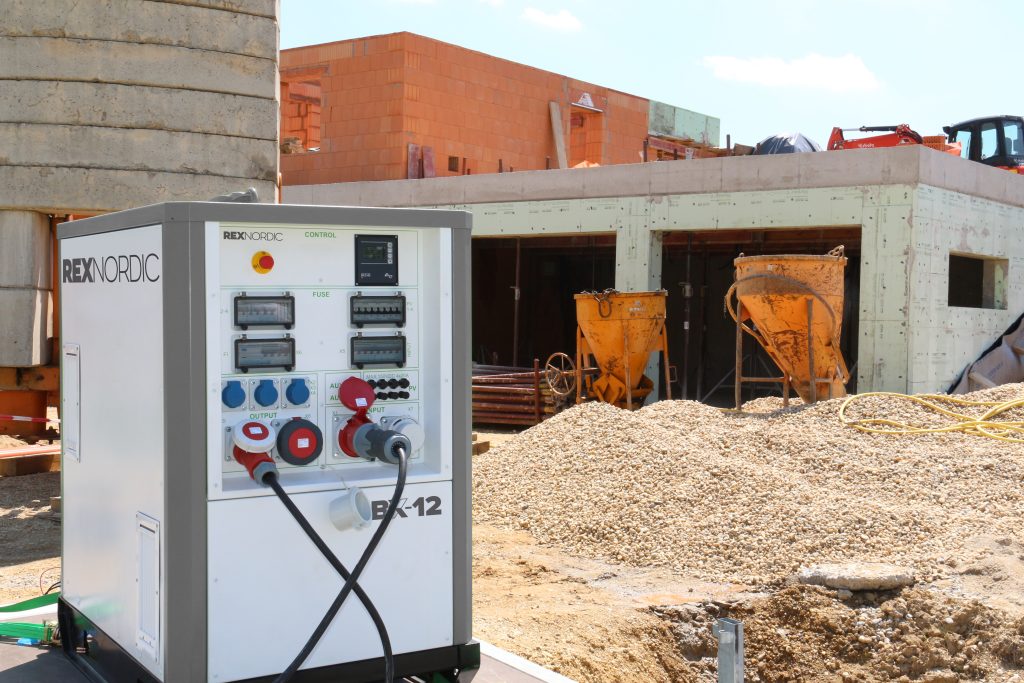
In today’s world, where industries, infrastructure, construction sites, event management, and emergency preparedness demand reliable, clean, and quiet power solutions, the BX e-Generator stands out as an innovation. It’s a next-generation portable electric generator designed to meet diverse energy needs across all professional environments. Rex Nordic’s BX e-Generator offers off-grid power solutions that reduce emissions, cut fuel costs, and deliver silent, emission-free energy where diesel generators fall short. Whether you need power for an industrial operation, a rail construction site, an urban infrastructure project, or a backup power supply for an emergency setup, the BX e-Generator provides efficiency, sustainability, and cost-effectiveness. Here’s why you should consider the BX e-Generator to complement or replace diesel generators Eco-friendly and cost-effective power management The BX e-Generator significantly reduces the runtime of diesel generators by cutting operational costs by up to 80% in fuel savings. Unlike traditional generators, it uses 99% recyclable AGM battery technology to store energy, providing clean and efficient power with a lower environmental impact—without the fire hazard and charging limitations of lithium batteries. Ideal for: Construction & infrastructure: Supports power tools, cranes, lighting, and mobile offices with low-emission energy. Urban & industrial sites: Perfect for tunnel work, manufacturing plants, logistic centers, and warehouses, where quiet, clean energy is a priority. Off-grid & remote locations: Ensures a reliable power source in areas without grid access, such as wind farms, railway projects, and emergency shelters. Peak shaving: smarter energy use The BX e-Generator helps businesses manage energy demand efficiently. By storing energy and supplying it during peak hours, it lowers reliance on fossil fuels and prevents costly demand spikes. It’s particularly useful for: Tower cranes & heavy machinery with fluctuating energy needs. Tunneling, rail, and road constructions, where steady power flow is essential. Silent and emission-free operation Traditional generators are noisy and polluting. The BX e-Generator runs under 45 dB, making it quieter than a refrigerator and completely emission-free. Best suited for: Festivals & outdoor events: Provides clean, silent power without disturbing the crowd. Construction sites in urban areas: Ensures low-noise, eco-friendly operation that meets regulatory standards. Emergency preparedness & crisis power: Delivers instant backup power without ventilation or fuel storage requirements. Multiple charging options for diverse needs The BX e-Generator adapts to different charging methods; this versatility makes an effective energy storage system for any setup. Solar panels Diesel generators Electricity grid Smart automation selects the most cost-effective power source available. Whether you’re powering a film set, an industrial facility, or an off-grid construction site, this portable generator ensures uninterrupted power while optimizing energy costs. Built to last – reliable in any environment The BX e-Generator is designed for tough environments and has an IP54 rating, making it dust- and waterproof. It performs reliably in extreme temperatures, wet conditions, and remote locations where traditional mobile generators struggle. Its durability makes it good choice for: Rail, road, and tunnel works that require continuous off-grid power. Wind and solar farms. Warehouses, logistics centers, and large-scale manufacturing plants. Emergency response teams, military bases, and remote aid operations. With forklift and crane compatibility, this portable generator is easy to move between job sites. Its plug-and-play functionality means no complex setup—just power on and go. Sustainability and cost savings One of the BX e-Generator’s biggest advantages is its ability to drastically reduce fuel consumption and eliminate costly grid connections. Cuts fuel costs by up to 80% compared to diesel generators. Fewer moving parts = lower maintenance costs on the BX e-Generator, ensuring long-term reliability with minimal servicing. Extends diesel generator lifespan by reducing work cycles, leading to lower maintenance costs and even greater savings over time. Compatible with solar panels for an even smaller carbon footprint. By eliminating excess fuel consumption, reducing emissions, and high maintenance costs, the BX e-Generator is the smart choice for professionals looking for an efficient, economical, and sustainable power solution. Efficient, reliable, and ready to go The BX e-Generator is a next-generation power solution designed for modern industries, construction, and event professionals. Contact us today to discover how the BX e-Generator can optimize your energy strategy!
Efficient and Environmentally Friendly Cooling for Professional Use: REXNORDIC cooler
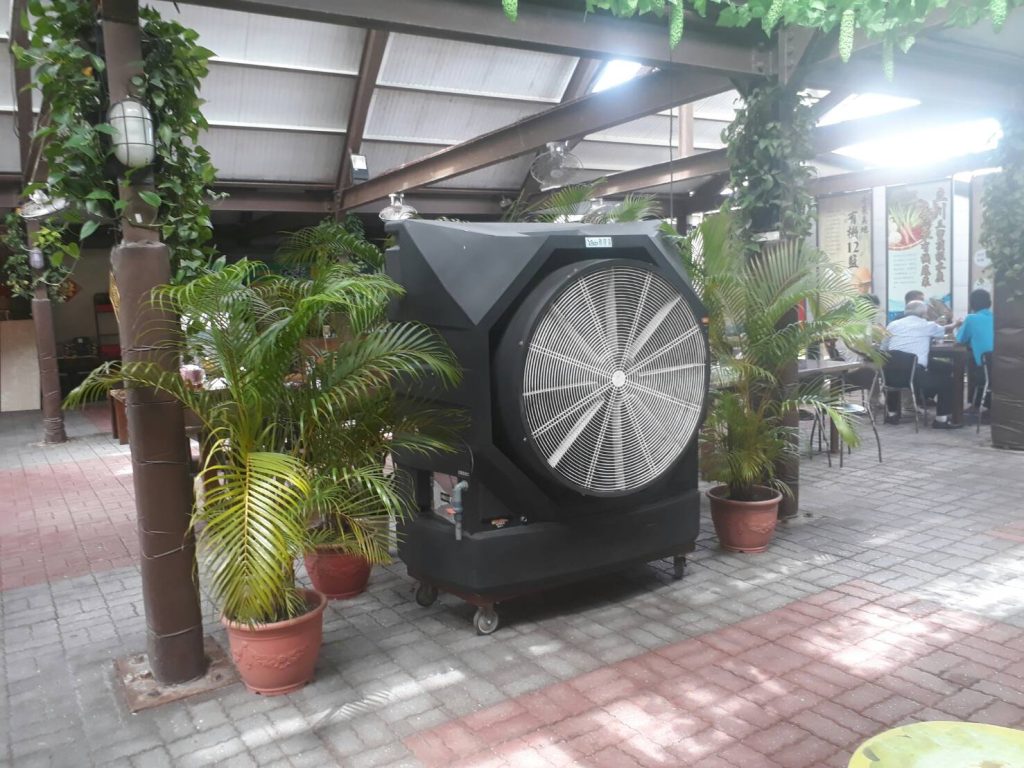
REXNORDIC evaporative coolers are excellent choices for professional use due to their efficiency, environmental friendliness, and low operating costs. This article discusses why an evaporative cooler is a good choice for professional use and where it can be used. Operating Principle of Evaporative Coolers Evaporative coolers operate on a simple yet effective principle: they use water evaporation to cool the air. As air passes through a wet filter, the water evaporates and absorbs heat from the air, lowering the air temperature. This process is highly energy-efficient as it consumes significantly less electricity than traditional air conditioning units. Benefits in Professional Use Energy Efficiency and Cost Savings: The Rex Nordic Ecocooler is a highly energy-efficient cooler. In professional environments where cooling is continuous, the energy savings can be significant, reducing overall costs. Environmental Friendliness: Unlike traditional air conditioners, evaporative coolers do not use environmentally harmful refrigerants. This makes them an ecologically sustainable option that reduces the carbon footprint. Ease of Use and Low Maintenance: The Rex Nordic Ecocooler is designed to be user-friendly and requires minimal maintenance. The device only needs regular cleaning and water refills, reducing downtime and maintenance costs. Improves Working Conditions: Evaporative coolers not only cool the air but also improve air quality by adding humidity. This is particularly beneficial in dry and dusty environments such as warehouses and industrial halls, where employee comfort and health can be significantly improved. Additionally, the Rex Nordic Ecocooler is equipped with built-in UV light that destroys all bacteria and viruses. Applications The Rex Nordic Ecocooler is suitable for various professional environments: Industrial Halls and Warehouses: Large and open spaces like industrial halls and warehouses benefit significantly from evaporative cooling. The Ecocooler can efficiently cool large areas, improving working conditions and increasing productivity. Construction Sites: On construction sites, working conditions can be challenging due to high temperatures and dust. An evaporative cooler can help keep the working area cooler and less dusty, enhancing worker comfort and safety. Agriculture and Greenhouses: Greenhouses and farms benefit from evaporative cooling as it helps maintain optimal temperature and humidity levels for the well-being of plants and animals. Events and Outdoor Spaces: At outdoor events such as festivals or sports events, evaporative coolers can provide comfort to large crowds. The Rex Nordic Ecocooler is portable and easy to install, making it an ideal solution for temporary cooling. Summary The Rex Nordic Ecocooler is an excellent choice for professional use due to its energy efficiency, environmental friendliness, ease of use, and versatile applications. Whether it’s an industrial hall, construction site, farm, or outdoor event, the Rex Nordic Ecocooler offers a reliable and cost-effective cooling solution that improves working conditions and reduces operating costs.
How Professional Evaporative Coolers Work?
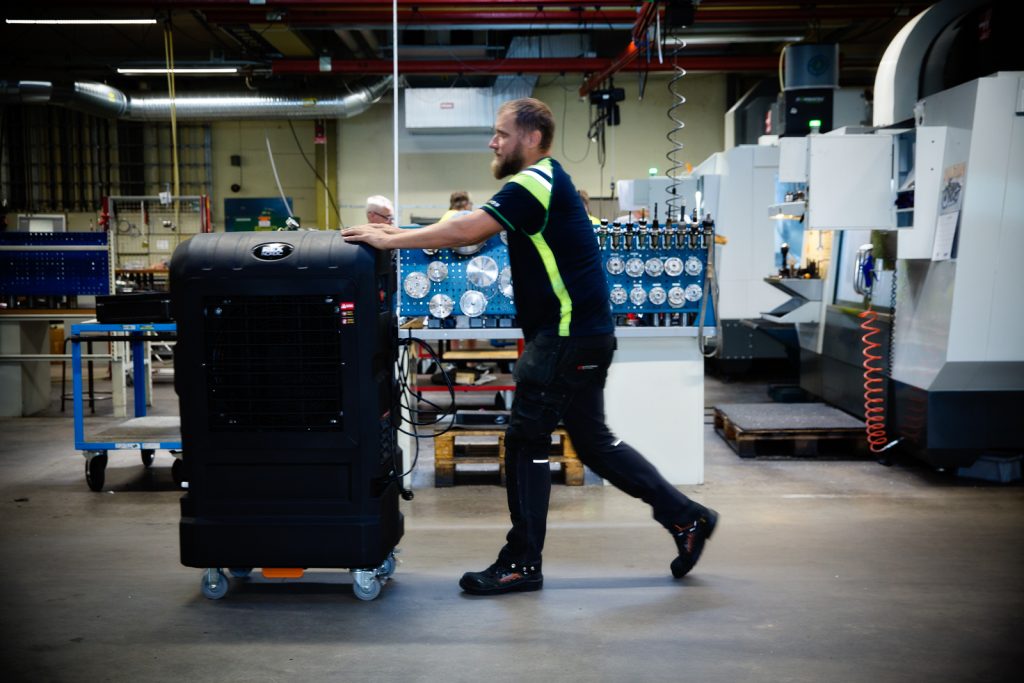
Evaporative coolers are an essential part of modern cooling technology, especially in industrial and other large-space cooling applications. Their advantages include energy efficiency and environmental friendliness compared to traditional air conditioning systems. This article examines the operating principle, applications, and benefits of evaporative coolers, as well as the technical aspects to consider when using them. Operating Principle of Evaporative Coolers Evaporative coolers utilize the evaporation process of water to cool the air effectively. This is based on a physical phenomenon where water evaporates and absorbs heat energy from the surrounding air, leading to a decrease in air temperature. Humidification and Heat Transfer Water evaporates when exposed to an airstream, and this process absorbs heat from the air, cooling it down. Coolers use special pads designed to maximize the surface area for water evaporation. These pads are often made of cellulose or plastic, which are hygroscopic and provide a large evaporative surface. Air flows through the pads via a fan, where it encounters water. The water evaporates, absorbing heat energy from the air, thus cooling it. Energy Consumption and Efficiency The energy consumption of evaporative coolers is significantly lower compared to traditional mechanical cooling systems because the process uses natural water evaporation and does not require substantial amounts of electrical energy. The efficiency of these systems depends on the ambient temperature and humidity. They work best in dry and hot conditions where the air’s moisture content is low, as this makes water evaporation most efficient. Operational Principle Adiabatic Cooling: Air is cooled through an adiabatic process where its temperature drops as it becomes humidified. This means that the air’s thermal energy is used for water evaporation without an external energy source. Ventilation and Pressure: In the cooler, air passes through the pads via a fan. The air flowing through the pads encounters moisture that evaporates and cools the air. The fan’s role is critical as it ensures sufficient airflow through the pads and guarantees uniform cooling. Water Circulation: In evaporative coolers, water circulates continuously. Water is pumped to the top of the pads, from where it flows down and evaporates due to the airstream. The recirculation system ensures even water distribution and optimizes the cooling process. Applications in Professional Use Evaporative coolers are widely used across various industries and other large-space cooling applications where efficient and cost-effective cooling is needed. Industrial Facilities Metal Industry: In hot factory halls where temperatures can rise extremely high, evaporative coolers provide an efficient cooling solution that helps keep the working environment tolerable and safe. Automotive Industry: Assembly lines and paint shops in car factories benefit from a cooler working environment, which improves worker efficiency and reduces errors. Food Industry: Evaporative coolers are ideal for cooling large storage and production areas where temperature control is critical to maintaining product quality. Data Centers Data centers require continuous and efficient cooling to prevent equipment from overheating. Evaporative coolers offer an energy-efficient alternative that can significantly reduce cooling costs in data centers. Using adiabatic cooling, data centers can also reduce their carbon footprint, which is increasingly important as environmental regulations tighten. Agriculture Greenhouses: Evaporative coolers help maintain optimal growing conditions, improving crop yields and growth rates. Cooler air reduces plant stress and enhances their resistance to diseases. Animal Shelters: Animal welfare improves in cooler conditions, leading to better health and productivity. This is especially important during the summer months when heat stress can negatively affect animal well-being. Advantages and Challenges Evaporative coolers offer many advantages. Advantages Energy Efficiency: Evaporative coolers use significantly less electrical energy compared to traditional cooling systems because they rely on the natural evaporation process. Environmental Friendliness: Since the system only uses water and air for cooling, its environmental impact is minimal, and the carbon footprint is small. This makes them an attractive option for organizations aiming to reduce their environmental impact. Cost Savings: Lower energy consumption and simple technology mean lower operating and maintenance costs compared to complex mechanical cooling systems. Technical Considerations and Design Portable evaporative coolers are highly convenient and flexible solutions for various professional cooling needs. Their technical design and use require special attention to the following aspects: Components and Materials Pads: The pads are the central part of the cooler responsible for water evaporation. They are often made of cellulose or plastic, providing a large evaporative surface and withstanding moisture and mechanical wear. Fans: Powerful fans ensure sufficient airflow through the pads. The performance of the fans directly affects the efficiency of the cooler. Water Systems: Water systems pump water to the top of the pads, from where it flows down and evaporates due to the airstream. The systems include filters and pumps that ensure water circulation and cleanliness. Device Placement Airflow Control: Optimal airflow and ventilation are essential to maximize cooling. Portable coolers should be placed to draw in as much dry and hot air as possible for the most effective evaporation. Water Source and Quality: A clean and adequate water source is vital for the system’s operation and longevity. Water quality affects the durability and efficiency of the pads and water systems. Considering Portability Durable Construction: Portable evaporative coolers must be durable and sturdy enough to be easily moved to different locations. This means strong frame materials and well-protected components. Practical Wheels: Large wheels enable easy movement of the device and are designed to withstand various floor materials and surfaces. Easy Connectivity: Coolers are easy to connect to electrical and water sources in different locations. They have practical connections and sufficiently long cables and hoses. Impact of UV Light UV light is used in evaporative coolers to improve water quality and prevent bacterial growth. Water Disinfection: UV light kills microorganisms and bacteria in the water, reducing biofilm and slime formation on the pads. This improves the system’s hygiene and reduces maintenance needs. Pad Cleanliness: UV light helps keep the pads free from biological impurities, enhancing their evaporative efficiency and extending their lifespan. Cost Savings: Using UV light reduces the need for chemical cleaning agents and improves the system’s
Why Choose the Rex Nordic HP19 Portable Heat Pump Over a Traditional Heat Pump?
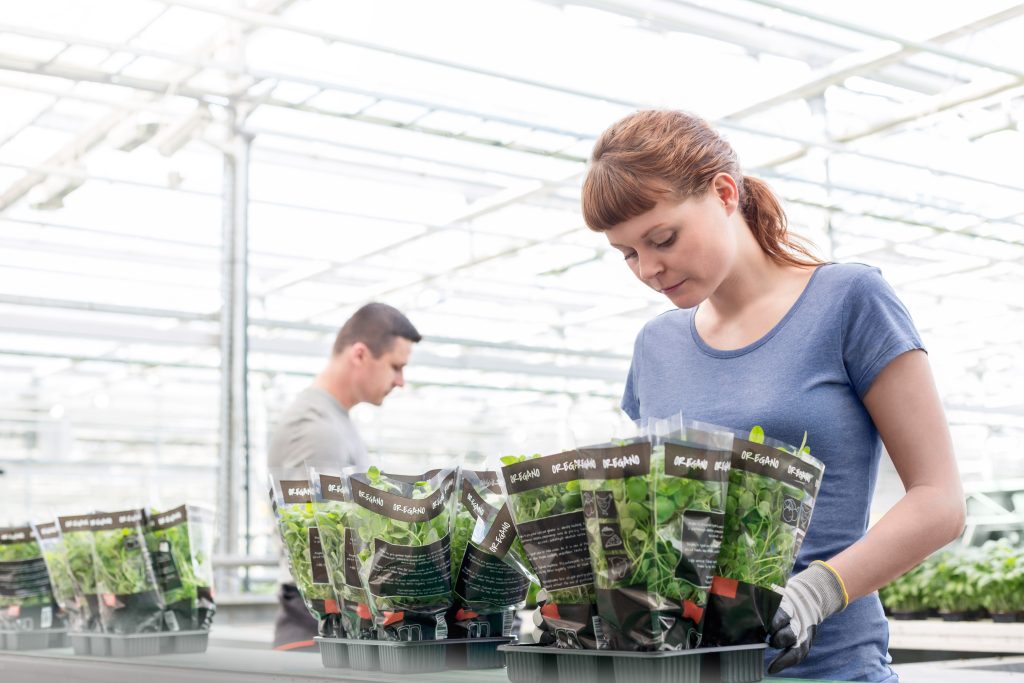
The Rex Nordic HP19 heat pump is an innovative solution that combines portability, efficiency, and ease of use. This heat pump offers unique advantages compared to traditional heat pumps, especially for professional use. Here’s why the Rex Nordic HP19 is an excellent choice for various situations and needs. Portability The Rex Nordic HP19 is designed to be easily portable, meaning you can take it with you as needed. This is especially useful on construction sites where heating or cooling is required in different places at different times. Its portability also makes it an excellent option for events, temporary workspaces, or other short-term needs. This feature allows you to use the device exactly where it’s needed most without the need to purchase multiple fixed units. No Fixed Installation Unlike traditional heat pumps, the Rex Nordic HP19 does not require fixed installation. This means the device can be put into use without major renovations or modifications, saving time and money. It also makes the device more flexible and easier to use in various spaces, such as rented premises or temporary buildings where fixed installations are not possible or desirable. No Electrician Needed Since the Rex Nordic HP19 does not require fixed installation, its setup does not require the assistance of an electrician. This makes the device even easier and faster to use, reducing installation costs. Its simple plug-and-play setup allows anyone to use it without special expertise. Durable Construction The Rex Nordic HP19 is built for heavy professional use. The device is made of steel, not plastic, ensuring its durability even in demanding conditions. This makes it a reliable and long-lasting option. The metal construction withstands impacts and wear well, which is important in industrial environments or construction sites where equipment can face harsh conditions. Components Suitable for Conditions The components of the device have been carefully selected to ensure they suit demanding conditions. This ensures efficient operation and longevity even when exposed to harsh operating conditions. The durability and reliability of the components are particularly important when the device is used in environments where conditions can vary significantly throughout the day. Professional-Grade Air Filters The Rex Nordic HP19 is equipped with professional-grade air filters suitable for dirty environments. Metal mesh filters are washable, making them easy to maintain and extending their lifespan. Additionally, the filters are easily accessible, making their maintenance and replacement straightforward. This is especially useful in places where air filters tend to get dirty, such as industrial plants or construction sites. Effective HEPA Filtration The device also offers an optional highly effective HEPA filtration. This ensures that air quality remains excellent, which is particularly important in production lines and other processes where clean air is essential. HEPA filtration removes fine particles, allergens, and other impurities from the air, improving working conditions and reducing the risk of illness. Precise Air Control With the Rex Nordic HP19, precise air control to the desired target is possible. The device can direct air up to 10 meters away, making it ideal for spot cooling in production lines or various processes. This feature allows targeted cooling or heating, improving energy efficiency and comfort. Moisture Removal The device has an effective dehumidification feature that can remove up to 120 liters of moisture per day. This is particularly useful in damp spaces where excess moisture can cause problems. Dehumidification improves indoor air quality and prevents mold and other moisture-related issues. Condensate Pump An optional condensate pump allows water to be pumped up to 5 meters upwards. This makes the placement of the device flexible and facilitates its use in different environments. Efficient condensate removal is important to ensure the device operates smoothly and without overload. Mobile Control The Rex Nordic HP19 can be conveniently controlled via a mobile app, the same app used for the Airrex heater. This allows for remote use and control of the device, enhancing its usability. The mobile control lets you adjust the device’s settings and monitor its operation in real-time, improving its usability and manageability. Warranty and Spare Parts The device comes with a 3-year warranty that also covers professional use. All spare parts are readily available from stock, ensuring fast and efficient maintenance service. This reduces downtime and increases the device’s utilization rate. A long warranty and good spare parts availability are significant advantages that ensure the device’s longevity and reliability. Summary The Rex Nordic HP19 is a versatile and durable heat pump that offers excellent advantages over traditional heat pumps. Its portability, ease of use, durable construction, and versatile features make it an ideal choice for various applications. Whether it’s a construction site, production line, or other professional use, the Rex Nordic HP19 provides a reliable and efficient solution for all heating and cooling needs. The device is designed to withstand heavy use and demanding conditions, so you can trust its performance and efficiency year after year.
Targeted Cooling in Large Spaces Can Save Up to 30% in Energy

Instead of wasting energy cooling unused areas, targeted cooling focuses specifically on zones that require it, making it a more efficient and cost-effective solution for businesses and industrial facilities. This article delves into the benefits of targeted cooling, explaining why it is the best choice for professional use in large spaces, and how it can economically, environmentally, and practically benefit your company. Energy Savings and Efficiency For businesses, energy consumption is a significant expense, and cooling an entire space consumes much more energy than targeted cooling. Targeted cooling focuses on cooling only the areas where employees and equipment need it, such as workstations, meeting rooms, or specific production lines. Studies have shown that targeted cooling can reduce energy consumption by up to 30% compared to traditional whole-space cooling systems (MDPI). This makes it particularly appealing for large spaces and companies where energy costs can be substantial. Rex Nordic’s mobile air heat pumps and evaporative coolers, known as eco-coolers, are designed to maximize energy efficiency. They can quickly and efficiently cool specific areas, making them an ideal choice for businesses looking to keep energy costs in check without compromising comfort. Environmental Friendliness Companies are becoming increasingly aware of their environmental impact, and reducing energy consumption is a key part of sustainable business practices. Targeted cooling reduces energy consumption and thereby also the carbon footprint. This is especially important for companies aiming to meet environmental standards and improve their sustainability goals. According to a report by the U.S. Department of Energy, targeted cooling can significantly reduce carbon dioxide emissions, particularly in large industrial facilities. Research by the European Environment Agency (EEA) also highlights that targeted cooling is an effective way to meet growing cooling demands while supporting EU energy and climate goals. Convenience and Flexibility Large spaces such as warehouses, production facilities, and office complexes benefit from the flexibility of targeted cooling. With targeted cooling, you can easily focus on the areas that need it most, such as workstations where employees spend most of their time. Rex Nordic’s mobile air heat pumps and evaporative coolers are easy to use and require no installation. Additionally, these devices are portable, so you can use them as needed in different departments or workspaces. Cost-Effectiveness Whole-space cooling systems are generally expensive to install and maintain. Targeted cooling offers a cost-effective alternative. Lower costs and reduced energy consumption make it a financially sensible choice for businesses. Rex Nordic’s products offer excellent value for money. They are durable and long-lasting, meaning the investment will pay off in the long run. Additionally, their ease of use and low maintenance requirements keep operating costs low. Summary Targeted cooling offers several advantages over whole-space cooling, especially in professional use and large spaces. It is energy-efficient, environmentally friendly, cost-effective, and improves comfort and employee health. Rex Nordic’s mobile air heat pumps and evaporative coolers are excellent choices that meet these needs by providing efficient and economical cooling. Consider targeted cooling the next time you look for cooling solutions for your business – it is a wise choice for both business and environmental reasons.
Moisture and diesel infrared heaters
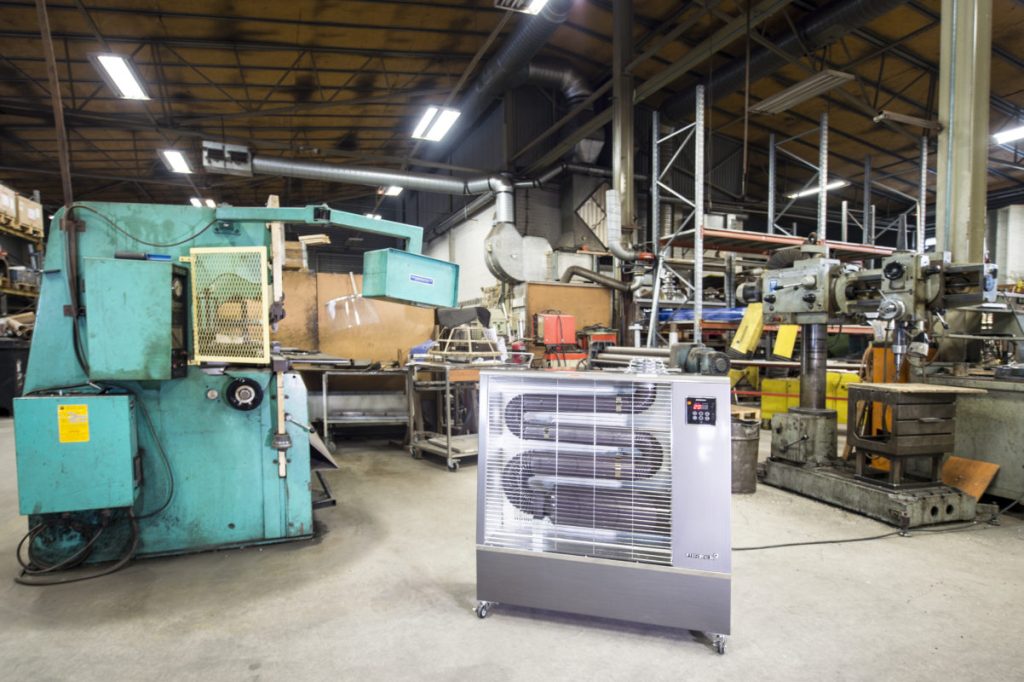
When heating cold spaces, the moisture tends to condensate on windows, metal structures or other structures in the heated space. From where does this moisture actually come? As a rule, air contains humidity in the form of water vapour: the hotter the air, the more humidity there is in it. Cold air cannot hold as much moisture as warm air. Air that contains water vapour heats up quicker than solid structures. Warmer air gathers more water vapour, but the solid structures in the heated space remain cool. The air close to the structures cools down, and the amount of water vapour in the air exceeds 100% RH. When the relative humidity of air exceeds 100%, water vapour in the air starts to condensate into droplets visible particularly on windows and metal surfaces in the heated space. You can also witness the same phenomena on a frosty pint of beer on a terrace in the summer. Two measurement units for humidity The amount of water vapour in the air, or humidity, is described by two different concepts. One expresses the amount of water in the water vapour found in a cubic metre of air. This is referred to as absolute humidity. The other, relative humidity, expresses the percentage of water vapour contained in the air. Relative humidity may vary from totally dry air (0%) to saturated air (100%) that contains the maximum amount of water vapour possible. Oil heaters produce carbon dioxide and water vapour Airrex infrared heaters burn diesel or fuel oil extremely efficiently, using almost 100% of the energy contained in the oil for the heating of the space. In practical terms, this means that all of the 10 kW of (heat) energy contained in a litre of fuel is utilised. 10-kW heating capacity is enough to significantly raise the indoor temperature in most heated spaces. Once the desired working temperature has been achieved, Airrex heater’s thermostat steps in to control the heater, reducing fuel consumption and emissions. A litre of fuel or diesel oil burnt creates 2.7 kg of carbon dioxide and 560 grams of water. Heating dries the air The capacity of air to hold water vapour is almost directly proportional to the temperature of the air. The colder the air, the smaller the amount of water vapour it can contain. This explains why heating is the most effective way to dry out spaces. Even then, formation or entry of humidity from outside the heated space must be prevented. If the relative humidity in a largish hall space is 40% at 0 degrees Celsius, each cubic metre of air in the space contains 1.9 grams of water vapour (water). If additional humidity is prevented from entering the space, raising the temperature in the space from zero to +20 degrees Celsius reduces relative humidity to five (5) per cent. It does not take much to heat air The average heat capacity of air is 1.01 kJ/kg/°C, based on which it is possible to calculate the output needed to heat it. To raise the temperature of one cubic metre of air by one degree, you need approximately 0.00035 kWh of heating power. If the heated space is, for example, 300 m3 in size, the power required to heat the air in it from zero degrees to +20 degrees is just 2.1 kWh. In reality, however, the above figure is not enough because of the significant effect the structures and objects in the heated space have on the required heating capacity, not to mention any heat loss due to structural leaks and ventilation in the space in question. Humidity created by an oil heater is not a risk The fact of the matter is as follows: to heat a 300-cubic-metre space from zero to +20 degrees, you require about 10 kWh of power, or one litre of oil, at maximum. This translates into 560 grams of water vapour that is mixed with 300 cubic metres of air. The amount of water in each cubic metre of air is, then, increased by about 1.9 grams. If the initial amount of water vapour per cubic metre of air in the heated space was 1.9 grams, the figure after the heating would be approximately 3.8 grams. At +20 degrees Celsius, this translates into about 30% relative humidity, which will not cause a moisture damage risk to any structure whatsoever. Unique benefits of oil-fired Airrex infrared heaters Radiation heaters do not heat the air as such, but the objects in the way of the infrared waves. Thus, the structures and objects in the heated space will become warm quicker than the air. This efficiently prevents condensation of humidity in the air on the surfaces, minimising the risk of damage due to moisture. Another factor that reduces the moisture risk is fuel. Many infrared heaters use liquefied petroleum gas, or LPG, which, when burnt, produces carbon dioxide and water. It is, therefore, a very clean fuel. Airrex heaters are in practice just as clean, but they produce considerably less water than LPG heaters. One (1) kg of LPG produces approx. 12.8 kWh of energy when burnt. At the same time, 2.99 kg of carbon dioxide and 1.63 kg (1,630 grams) of water vapour are produced. Using diesel oil, the amount of water vapour produced to achieve the equivalent heating power is approx. 720 grams – less than half of that with LPG. This is a significant difference, at least for anyone wishing to minimise the risk of moisture damage. Infrared heat dries out structures As described above, infrared heating increases the temperature of the structures and objects in the heated space rather than the air. This prevents condensation of moisture on the surfaces of the structures. Infrared heaters can also be used to remove humidity in applications such as the drying of moisture damage from concrete structures, for example. If there is moisture in the structures of the heated space from the time of construction or for some other reason, infrared heaters can be used
What makes infrared heaters better than fan heaters?
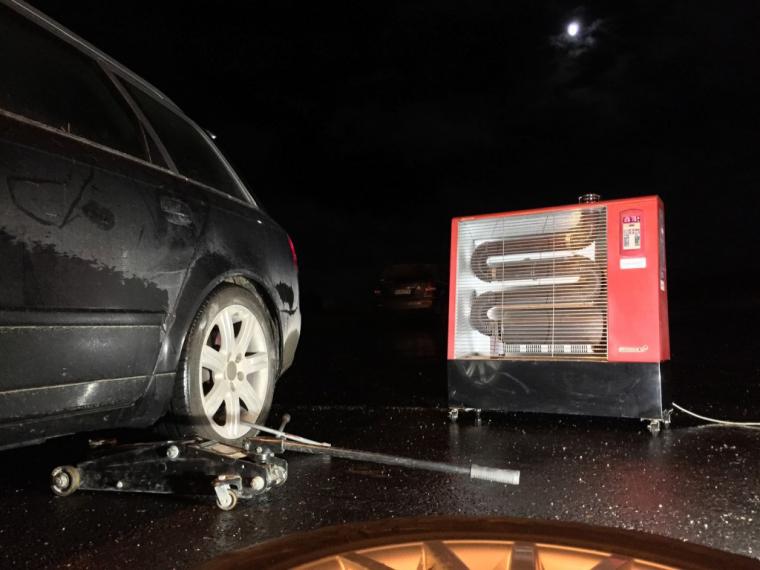
There are many significant differences between an infrared heater and a traditional fan heater. For instance, instead of blowing, infrared heaters radiate heat. Infrared radiation heats materials, not air. To learn more about infrared radiation, visit, for example, Wikipedia. You can feel the heating effect of an infrared heater even outdoors in windy weather because the heat will get through instead of being whisked away with the wind. The warm air blown from the fan heater will disappear in the wind right out of the heater. Airrex infrared heaters are an excellent choice for, for example, service tasks that have to be performed outdoors, e.g. changing a tyre of a car or repairing machinery (forest harvester, tractor, etc.) in field conditions.
Large space heaters and exhaust management

Not many enjoy the exhaust gases produced from burning diesel or fuel oil. A lot of people have found that the gases cause unpleasant symptoms in the respiratory system, mouth and throat, or even eyes, as the most sensitive people have reported.Exhaust management is not a problem for users of Airrex large space heaters that burn the fuel so efficiently that a separate exhaust outlet to the outside is not needed. If the combustion is incomplete, the exhaust will contain various harmful compounds. Unburnt hydrocarbons, carbon monoxide, various particulates, nitrous oxide and, of course, carbon dioxide. In case of high-quality hydrocarbon-based fuel, such as diesel, it is possible to achieve near-perfect combustion, meaning that the exhaust emissions consist mostly of carbon dioxide that is not dangerous as such, and water in the form of water vapour. Perfect combustion is the reason why Airrex infrared heaters do not require separate exhaust piping. Kymenlaakso University of Applied Sciences (KYAMK) is one of the few institutes in Finland that perform emission measurements. Marko Piispa, leader of the emission measurement unit, recalls that the emissions from the Airrex heaters were low. He does not comment on their safety when used in sealed spaces: this can be determined by studying the guidelines and limit values set out by the authorities. Airrex infrared heaters and exhaust gases According to the Decree of the Ministry of Social Affairs and Health on concentrations known to be harmful (HTP) and the Ministry of the Environment procedure on carbon dioxide levels in indoor air, the maximum allowed concentration of carbon dioxide during normal weather conditions and while the room is occupied is 1,200 ppm. The acceptable exposure limit at workplaces during an 8-hour workday is 5,000 ppm. Correspondingly, the amount of carbon monoxide in the air during an 8-hour workday should not continuously exceed 10 mg/m3. The limit for nitrogen dioxide concentration known to be harmful is 6 ppm, or 11 mg/m3, over 15 minutes of exposure. Operating at full capacity, Airrex AH-300 produces one milligram of carbon monoxide per cubic metre of air, meaning that the recommended limit value would not be reached during 10 hours of working. As heaters rarely operate at full capacity all the time, the maximum working time is much longer. And, if normal ventilation is ensured, carbon monoxide creates no risk whatsoever. Harmless as such, carbon dioxide is, in fact, very important for the human body. According to the emission report by KYAMK, exhaust gases from Airrex AH-300 contain 10% of carbon dioxide that is very quickly mixed with the air in the room space. This is why the carbon dioxide emissions are not considered significant. Nitrogen oxides created when burning diesel and fuel oil are considered hazardous to health. Noteworthy in the emission measurement report of an Airrex AH-300 operating at full capacity is that the nitrogen oxide emissions with biodiesel were 201 mg/m3 while those with regular diesel were 183 mg/m3. If exhaust gas is inhaled directly from the end of an AH-300 exhaust pipe, nitrogen oxides cause more stress on the body than recommended (6 ppm, or 11 mg/m3, 15 min of exposure), but the concentration decreases significantly when the exhaust gases mix with the air in the heated space. As regards an Airrex AH-300 operating at full capacity, the value will remain below the concentration known to be harmful (HTP) determined by the authorities when the volume of the heated space is approximately 200 cubic metres. This translates into a room that is approximately 8 x 10 x 2.5 metres in size. If the ventilation of the heated space is in line with the recommendations, i.e. a complete air change per every two hours, Airrex AH-300 can be used in spaces smaller than 100 cubic metres in size without risk of any health hazards due to nitrogen dioxide. With a capacity of 13–15 kW, Airrex AH-300 warms up such a small space very quickly, after which full capacity is no longer needed. This means less nitrogen oxide emissions and, subsequently, negligible health hazards thereof. Emissions in summary In summary, Airrex infrared heaters do not produce dangerous amounts of carbon monoxide – and no separate exhaust piping is required. The carbon dioxide that is created is no more a health hazard than carbon dioxide normally found in the air. During initial heating in a small space, the level of nitrogen oxides created may rise to concentrations determined hazardous by the authorities. The risk can be reduced by staying away from the (small) space during the initial heating and ensuring normal ventilation thereafter. The risk can be eliminated entirely by leading the exhaust gases outside the heated space. The smaller amount of nitrogen oxides created during the less capacity-intensive continuous heating keeps the level below the concentrations known to be hazardous. In a nutshell: a well-designed diesel heater can achieve such perfect combustion that there is no need for a separate exhaust pipe. After reviewing the calculations, this is also confirmed by Marko Piispa, who performed the emission measurements: “Emissions from the Airrex heater were quite low. They do not present a health risk in a large hall with appropriate ventilation.” Visit our webstore to read more about the safe and efficient Airrex heaters .
